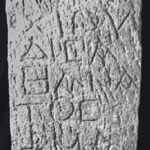| Artefact ID | 1284 |
| TM ID | TM 701027 |
| Findspot (DEChriM ID) | 68 (al-Filusiyya) | Class | Funerary element, Textual |
| Material | Stone |
| Writing medium | Inscription |
| Text content | Subliterary |
| Language | Greek |
| Description | SEG LIX 1875: Epitaph of Maria. Dahari & Di Segni 2009, no. 3: Anthropomorphic stela of beach-rock of slightly tapering rectangular shape, surmounted by a head, with a tang at the bottom for standing the tombstone up at the head of a cist grave. H. 139 cm; W. 40 cm at the top, 33 cm at the bottom. The red paint that fills the engraving of the face and of the letters is well preserved. The characters are square, except for round omicron. The inscription begins and ends with a monogrammatic [staurogram]; another monogrammatic cross is engraved before the name of the deceased that, unlike most of the other tombstones from the el-Huweinat cemetery, appears at the end. |
| Selection criteria | Christian terms/formulas/concepts, Christian onomastics, Christian symbols/gestures/isopsephy |
| Date from | 350 |
| Date to | 499 |
| Dating criteria | Phrasing and palaeography point to 4th-5th c. according to ed. pr. |
| Absolute/relative date | Relative date |
| Archaeological context | SEG LIX-1873-1882: One of the ten anthropomorphic stelai acquired in the antiquities market in the 1970s by the Israel Museum in (Jerusalem) and the Israel Antiquities Authority; returned to Egypt in 1993; all stelai come from the Byzantine nekropolis at el-Huweinat 2 km south of Ostrakine (east of Lake Sirbonitis = Sbakhat el-Bardawil; northern Sinai). |
| Accession number | Formerly: Jerusalem, Israel Antiquity Authority 4464. Returned to Egypt in 1993 (present location unknown). |


 Json data
Json data




